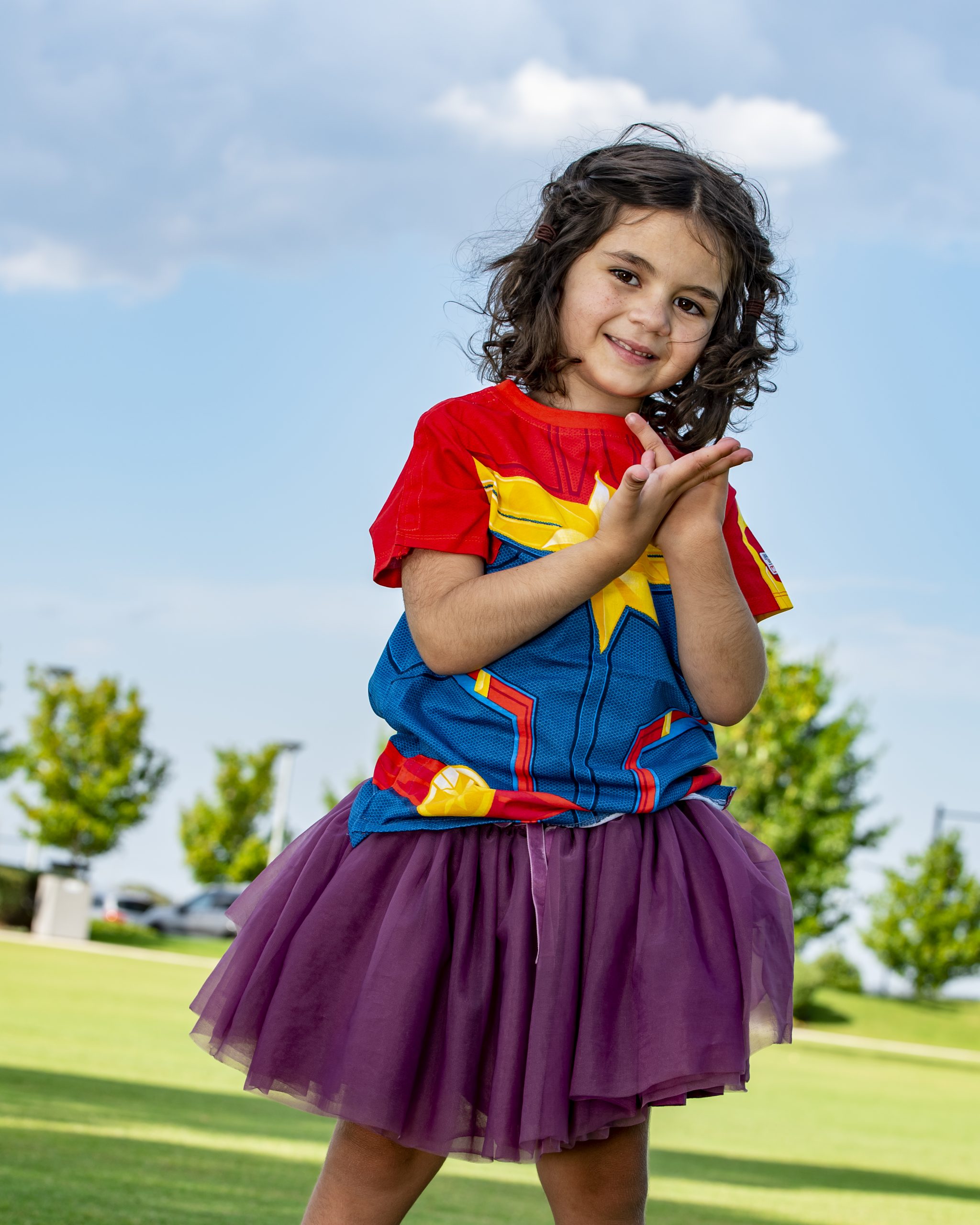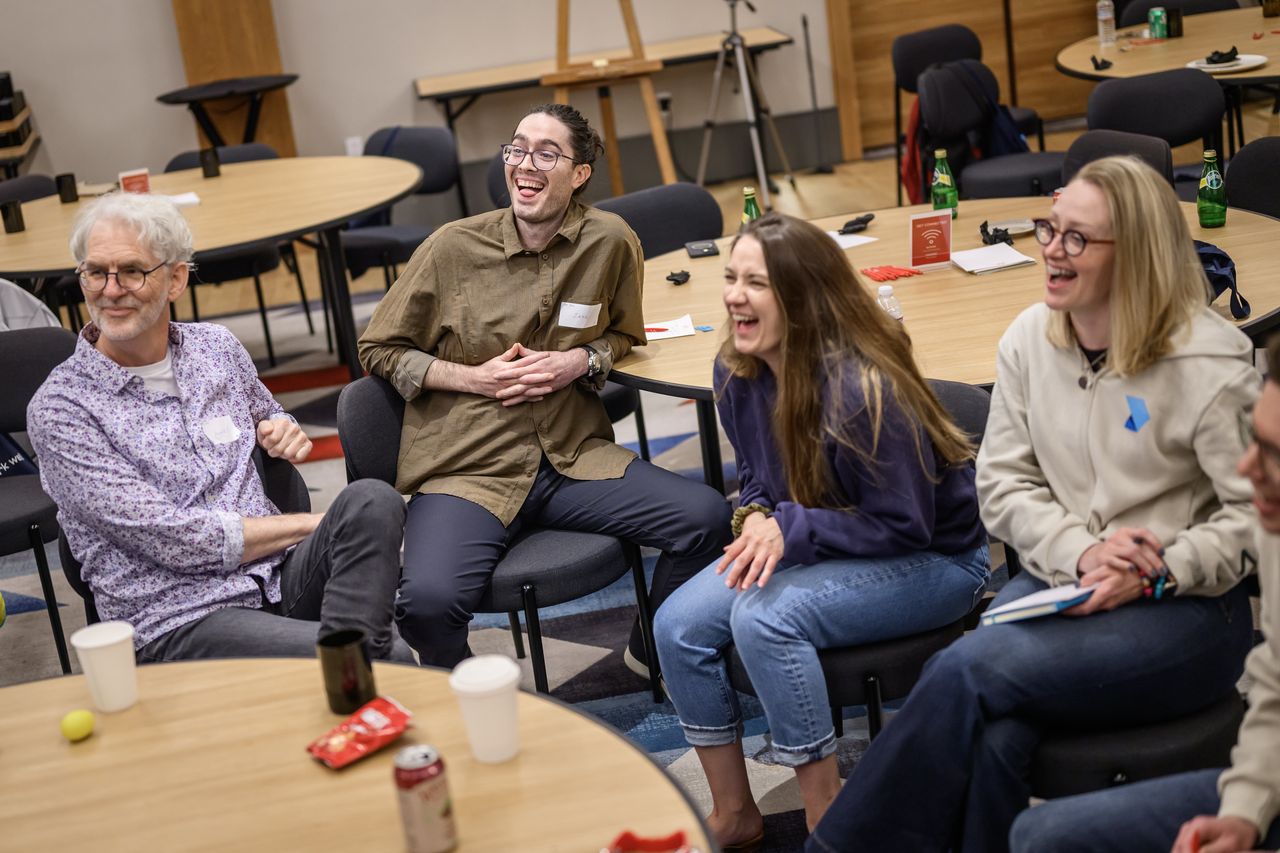The Australian invention empowering sick children through tough times
This specially designed medical garment draws on the ‘Batman effect’ to give young patients the strength to persevere
It might not seem like much, being able to choose what you wear. But for children being treated for life threatening conditions and illnesses, it’s more agency than they’re used to.
Regularly prodded with needles, drips and assessed by monitors, as well as being scanned, x-rayed and more, they often have little control over what’s happening – or being done to – their own bodies during hospital stays. It’s often a frightening, bewildering experience.
And it’s not just the sick children who feel powerless.
When tradie Jason Sotiris’s daughter was diagnosed with a life threatening illness as a young child, he was at a loss to help give her the strength and support she needed to endure.
Creating a hospital friendly range of clothing, known as Supertees, was the result. Designed to be MRI and PET scan friendly, the hospital grade garments provide medical staff with easy side and shoulder access to the patient while still looking like a standard t-shirt.
Starting from scratch and with no experience in the clothing industry, Sotiris trialled a number of designs and fastening options before settling on the end product.
But key to their success is the Marvel superhero characters that are printed on them.
Sotiris said the garments are designed to help put young kids in the best frame of mind as possible as they face the toughest times of their lives.
“These children have to face these things and there’s not a lot of choice for them,” he said. “We want them to be able to choose whatever makes them feel stronger.”
Available free to families of kids facing the toughest health battles, the Supertees are in high demand.
“What you wear matters, what you wear can represent you in a certain way and hospital gowns are a symbol of being unwell,” Sotiris said. “It’s something given to those who are unwell.
“We wanted to create something that someone would wear and make them stand out in a special way. How good would it be that something is so cool and fun that it makes healthy kids just a little bit jealous, because it’s usually the other way round.”

But the benefits of the Supertee go way beyond having a desirable superhero costume.
Sotiris pointed to a joint study by researchers at University of Pennsylvania, University of Minnesota, University of Michigan in the US called The Batman Effect: Improving Perseverance in Young Children.
The study found that when four and six year olds ‘impersonated’ an ‘exemplar other’ like a superhero character, they showed much higher levels of perseverance when faced with challenging tasks. The findings of the study supported what Sotiris already suspected.
“So it’s not the child going through the MRI, it’s Wonder Woman,” he said. “How would she act in this situation? We’re trying to use the power of imaginative play.”
While Disney, who has the rights to the Marvel characters’ artwork, has waived licensing fees for the Supertees, the charity is not receiving further monetary support.
Sotiris is seeking high wealth individuals and corporate partners to help him achieve his aim of supplying Supertees to 10,000 seriously ill children around Australia.
“I don’t want parents to have to pay for them – they are going through enough,” he said. “Parents are often working less and navigating that with their employer, or they may have left their job to care for their sick child. It would be great to offer them something to make things a little bit easier.”
He is in talks with other community-minded groups such as the NRL and the NSW Police (to create a Tactical Cancer Fighting Unit Supertee) to extend the range and give more kids the mental boost they need.
Just as it is for any parent who has watched their child go through this experience, it’s still a very personal quest for Sotiris. His daughter, now 11 years old, finished treatment some time ago and her last scan earlier this year was clear. Giving back to other parents and children has helped him process his own difficult memories of that time.
“In 2018 I held my daughter’s hand in one hand and a Supertee in the other and I went back to the hospital,” he said. “I started replacing the memories I had of her treatment with these wonderful memories of helping these kids with the Supertee.”
You can support the Supertee initiative here.
This stylish family home combines a classic palette and finishes with a flexible floorplan
Just 55 minutes from Sydney, make this your creative getaway located in the majestic Hawkesbury region.
As Paris makes its final preparations for the Olympic games, its residents are busy with their own—packing their suitcases, confirming their reservations, and getting out of town.
Worried about the hordes of crowds and overall chaos the Olympics could bring, Parisians are fleeing the city in droves and inundating resort cities around the country. Hotels and holiday rentals in some of France’s most popular vacation destinations—from the French Riviera in the south to the beaches of Normandy in the north—say they are expecting massive crowds this year in advance of the Olympics. The games will run from July 26-Aug. 1.
“It’s already a major holiday season for us, and beyond that, we have the Olympics,” says Stéphane Personeni, general manager of the Lily of the Valley hotel in Saint Tropez. “People began booking early this year.”
Personeni’s hotel typically has no issues filling its rooms each summer—by May of each year, the luxury hotel typically finds itself completely booked out for the months of July and August. But this year, the 53-room hotel began filling up for summer reservations in February.
“We told our regular guests that everything—hotels, apartments, villas—are going to be hard to find this summer,” Personeni says. His neighbours around Saint Tropez say they’re similarly booked up.
As of March, the online marketplace Gens de Confiance (“Trusted People”), saw a 50% increase in reservations from Parisians seeking vacation rentals outside the capital during the Olympics.
Already, August is a popular vacation time for the French. With a minimum of five weeks of vacation mandated by law, many decide to take the entire month off, renting out villas in beachside destinations for longer periods.
But beyond the typical August travel, the Olympics are having a real impact, says Bertille Marchal, a spokesperson for Gens de Confiance.
“We’ve seen nearly three times more reservations for the dates of the Olympics than the following two weeks,” Marchal says. “The increase is definitely linked to the Olympic Games.”

Getty Images
According to the site, the most sought-out vacation destinations are Morbihan and Loire-Atlantique, a seaside region in the northwest; le Var, a coastal area within the southeast of France along the Côte d’Azur; and the island of Corsica in the Mediterranean.
Meanwhile, the Olympics haven’t necessarily been a boon to foreign tourism in the country. Many tourists who might have otherwise come to France are avoiding it this year in favour of other European capitals. In Paris, demand for stays at high-end hotels has collapsed, with bookings down 50% in July compared to last year, according to UMIH Prestige, which represents hotels charging at least €800 ($865) a night for rooms.
Earlier this year, high-end restaurants and concierges said the Olympics might even be an opportunity to score a hard-get-seat at the city’s fine dining.
In the Occitanie region in southwest France, the overall number of reservations this summer hasn’t changed much from last year, says Vincent Gare, president of the regional tourism committee there.
“But looking further at the numbers, we do see an increase in the clientele coming from the Paris region,” Gare told Le Figaro, noting that the increase in reservations has fallen directly on the dates of the Olympic games.
Michel Barré, a retiree living in Paris’s Le Marais neighbourhood, is one of those opting for the beach rather than the opening ceremony. In January, he booked a stay in Normandy for two weeks.
“Even though it’s a major European capital, Paris is still a small city—it’s a massive effort to host all of these events,” Barré says. “The Olympics are going to be a mess.”
More than anything, he just wants some calm after an event-filled summer in Paris, which just before the Olympics experienced the drama of a snap election called by Macron.
“It’s been a hectic summer here,” he says.

AFP via Getty Images
Parisians—Barré included—feel that the city, by over-catering to its tourists, is driving out many residents.
Parts of the Seine—usually one of the most popular summertime hangout spots —have been closed off for weeks as the city installs bleachers and Olympics signage. In certain neighbourhoods, residents will need to scan a QR code with police to access their own apartments. And from the Olympics to Sept. 8, Paris is nearly doubling the price of transit tickets from €2.15 to €4 per ride.
The city’s clear willingness to capitalise on its tourists has motivated some residents to do the same. In March, the number of active Airbnb listings in Paris reached an all-time high as hosts rushed to list their apartments. Listings grew 40% from the same time last year, according to the company.
With their regular clients taking off, Parisian restaurants and merchants are complaining that business is down.
“Are there any Parisians left in Paris?” Alaine Fontaine, president of the restaurant industry association, told the radio station Franceinfo on Sunday. “For the last three weeks, there haven’t been any here.”
Still, for all the talk of those leaving, there are plenty who have decided to stick around.
Jay Swanson, an American expat and YouTuber, can’t imagine leaving during the Olympics—he secured his tickets to see ping pong and volleyball last year. He’s also less concerned about the crowds and road closures than others, having just put together a series of videos explaining how to navigate Paris during the games.
“It’s been 100 years since the Games came to Paris; when else will we get a chance to host the world like this?” Swanson says. “So many Parisians are leaving and tourism is down, so not only will it be quiet but the only people left will be here for a party.”
This stylish family home combines a classic palette and finishes with a flexible floorplan
Just 55 minutes from Sydney, make this your creative getaway located in the majestic Hawkesbury region.


















